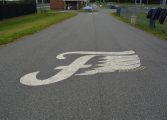“It’s not very productive but we farm it because we love it,” said Snoddy of his land. “I’m killing myself because I love it.”
If large tracts of land are broken up and sold, it could lead to more development. Snoddy pointed to the financial impact a higher population would have on the county by driving up spending on more schools, deputies, buses, roads, and infrastructure. “My fields don’t cost you a thing,” he said. The taxes he pays “might not be as much as you’re getting from someone else, but you’re getting [them] for nothing.”
O’Brien addressed what he saw as a consistent misperception that he wants to eliminate land use in Fluvanna. “The question isn’t if land use a good thing or a bad thing, it’s whether it’s being enforced fairly,” he said.
“So you’re saying we don’t have a properly applied land use program?” Snoddy asked.
O’Brien responded by saying he would like to see some sort of income verification attached to land use in order to weed out people who claim the tax deduction without actually putting their land to a bona fide use – from which they would, theoretically, receive an income. For example, he referenced a hypothetical resident who allows his grass to grow and has it cut occasionally. “It’s not fair that he should have his land discounted by 95 percent,” O’Brien said. “That doesn’t feel right to somebody who has one acre of land who has to cut their grass.”
“Why should they pay the same as somebody with a house and a third of an acre?” Snoddy replied. “Why should they pay the same when that house and the third of an acre is costing for sheriff’s deputies, if they have two kids it’s costing for a school bus – why should that open land that’s sitting there not costing you anything… It’s like a golden egg sitting there. You’re receiving money for it and it doesn’t cost you a red cent.”
O’Brien wasn’t convinced. “So your argument is essentially, because I own a lot of land, I shouldn’t pay taxes because –”
“We do pay taxes,” Snoddy interrupted.
“You’re paying 95 percent less than –” O’Brien began.
“I pay the same on my house and two acres” as everyone else, Snoddy said. A residence and the first two acres of land on which it sits aren’t eligible for land use.
Supervisor Mozell Booker addressed what she believes is a prominent fear in the community that the Board is seeking to end the land use program. “We are not trying to get rid of land use,” she said. “This is the first time we’ve ever brought it out on the table, had experts here to tell us what’s what.”
“It is not my idea to eliminate land use. I think it’s a good thing,” said O’Brien. To demonstrate the opposite point of view from that espoused by the day’s speakers, he read from a letter sent to him by a “little old lady” with minimal income. She wrote that, because of land use, she pays more in taxes than her neighbor who has a lot of land. Her taxes are a hardship, she said, and she finds the situation unfair.
When the time for public comments arrived at the beginning of supervisors’ evening meeting, seven residents added their voices to those urging for land use to remain the same in Fluvanna.
“The cornfields and hardwoods that surround my home don’t use county services,” said Andrew Pullen. “Some of your surrogates have suggested that some of your constituents subsidize the farmers and the landowners. But with more than a third of the county’s population in half the homes, the farmers and the landowners actually protect your constituents’ tax dollars. So my question is: Who actually subsidizes who?”
Minor Eager, husband of Supervisor Trish Eager, said, “I’m sorry this discussion is having to take place. If land use was done away with in the county I would have to sell my entire property for whatever I could get for it.” Rather than increasing the value of land in land use, Minor Eager proposed reducing its value even further, which would result in a lower tax bill for participants. He also proposed eliminating rollback taxes for residents who are 65 years or older and have held property for 30 years or more.
“To attack the family farms and really, actually threaten us with what would amount to bankruptcy in running us off of our farms, our lifelong farms, is a heartbreaking situation,” he said.
The county gathered several land use experts to give presentations to supervisors on the intricacies of land use, which is often complicated. About 22 people, including the experts but excluding staff and media, gathered to hear the presentations.
Dr. Gordon Groover, extension economist [in] farm management from Virginia Tech, told supervisors that land use was passed in 1972 and became effective for tax year 1974. Its purpose, he said, was to promote proper land use planning and orderly development, support a balanced economy and ameliorate pressures that force conversion of real estate. The average farm size in Fluvanna is 81 acres, he said.
Dean Cumbia, director of forest resource management for the Virginia Department of Forestry (VDF), spoke about how forestal land use operates. Approximately 61 percent of Fluvanna’s land is forested, he said, which amounts to about 100,000 acres and is close to the statewide average.
Recently there has been some controversy over whether land use parcels, including those owned by elected officials, fall within minimum acreage requirements. O’Brien tried to clarify whether a parcel of less than 20 acres, the supposed minimum, can actually qualify for forestal use.
Ed Zimmer, member of the Planning Commission and VDF chief of operations, said, “If it’s part and parcel of a tract that applies for agricultural land use, and the trees are being managed for commercial timber purposes, then it can qualify.” So five acres of forestal land, though they fall short of the 20-acre minimum, would qualify if they were attached to a qualifying agricultural parcel, he said.
“We call those residual acres,” said Mel Sheridan, who as commissioner of the revenue is responsible for enforcing the program. “We have no individual parcels of timber that are in the program that are less than 20 acres. And I mean 20 acres. If they’re 19.98 acres then they’re not given that opportunity. And that’s caused hard feelings. We’re very consistent.”
John Thompson, Fluvanna’s Virginia Cooperative Extension agent, said “agriculture does not fit in perfect boxes.” Though O’Brien has called for closer enforcement of regulations, possibly through additional documentation, Thompson said, “I don’t know that we can define [agriculture] so closely that we can answer all the questions on a piece of paper.” O’Brien agreed that a bartering system, which can be common in agriculture, could be hard to formally document.
As the afternoon wrapped up, Sheridan urged the Board to put the issue to rest. “The policies we have in place…they work,” he said. “You owe it to the county to please make a decision. Don’t continue to belabor this.”
O’Brien continued to urge for tweaks to the rules that would, he said, make the program seem more fair to the 65 or 70 percent of residents who don’t qualify. “I just find it hard to understand why we are so resistant to looking at how we can better execute on the program,” he said.




